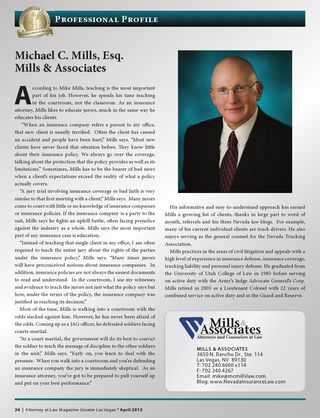Mr. and Ms. Turnbow were not seeing eye to eye. She wanted him to stop the pickup truck. He didn’t want to. His arguments to her made sense. They were driving in the middle of nowhere. It was 10:00 at night on September 16, 1981. They would be home to Lunning, Nevada in just a few minutes. But after an evening of drinking, Ms. Turnbow’s bladder took precedence. So he pulled onto the shoulder of U.S. 95.
However, the spot where he stopped didn’t suit Ms. Turnbow. The bushes on that side of the road weren’t big enough to give her the concealment she wanted. She crossed to the east side of U.S. 95 and located proper coverage there. Having relieved herself, Ms. Turnbow thought about walking the rest of the way to Luning without Mr. Turnbow. However, in spite of the fact that her blood alcohol content was two and one-half times the legal limit, she thought better of it and headed back to the pickup truck.
At the same time, Mr. and Ms. Wasden were driving their company’s tractor trailer southbound from Nampa, Idaho heading to Los Angeles, California. They were carrying beef carcasses that were hung from the ceiling of the refrigerated trailer. Wasden had his headlights on and the trailer was well lit well. Mr. Wasden saw the lights of the Turnbow pickup truck parked ahead on the shoulder of the flat straight road. He picked up his CB radio and called to the trucks behind him warning about the stopped pickup. Like any good trucker, he slowed his speed to 50 mph and with no oncoming traffic he moved the rig toward the center of the road to give wide berth to the parked pickup.
Just then, Ms. Turnbow started to cross the highway. Mr. Wasden’s headlights illuminated her when she was about half way across the road. He swerved to the left and onto the east shoulder. Lucky for Mr. Wasden the trailer didn’t overturn. Unlucky for Ms. Turnbow, the right side of the trailer struck her causing her serious injuries.
She brought a law suit alleging that Wasden should have focused less on the pickup truck parked on the side of the road and more time on what was happening on the road in front of him. The facts of the case are reported in Turnbow v. Wasden, 608 F.Supp. 237 (D. Nev. 1985). In the end, the court found that the truck driver Wasden shared some of the blame. However, the court decided that Ms. Turnbow’s negligence was greater than that of Mr. Wasden.
Under Nevada law, NRS 41.141 a Plaintiff cannot recover unless her negligence is equal to or less than that of the Defendant. The court found that Ms. Turnbow’s negligence was greater that Mr. Wasden’s negligence. The court ruled in the truck driver’s favor. Ms. Turnbow recovered nothing from the lawsuit.
If the truck driver and Ms. Turnbow had shared negligence equally at 50%, Ms. Turnbow would have recovered 50% of her total damages. If Ms. Turnbow’s negligence had been 25%, her total damages would have been reduced by that same percentage. But when a Nevada Plaintiff’s damages are in excess of the Defendant’s, Plaintiff recovers nothing. This is a modified version of the legal doctrine of “comparative fault”. If Nevada followed a pure comparative fault doctrine (like Arizona for example) and Ms. Turnbow’s negligence had been 90%, she still would have recovered 10% of her total damages. But since Nevada law applied to this case, all that Ms. Turnbow got was the judge’s sympathy.
If you have questions about how the comparative fault law works in Nevada, call Mike at 702-240-6060 x114 or email him a mike@mcmillslaw.com.
 Follow
Follow Email
Email


